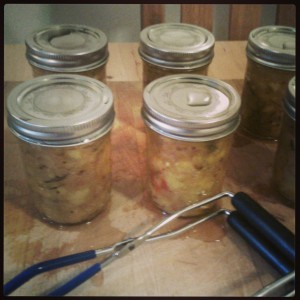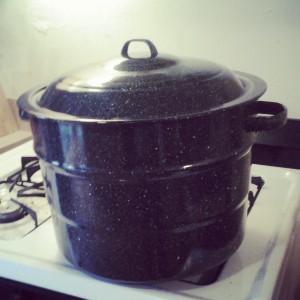Posts Tagged ‘Mango’
 One of my goals for the summer is to start canning. Â I’ve joined a CSA and expect to have a lot of produce around. Â Plus, the farmer’s market will be calling to me every Saturday morning. Â I hope save the summer’s bounty for the dark days of winter. Â But I’ve never canned a thing before. Â At least not until today.
One of my goals for the summer is to start canning. Â I’ve joined a CSA and expect to have a lot of produce around. Â Plus, the farmer’s market will be calling to me every Saturday morning. Â I hope save the summer’s bounty for the dark days of winter. Â But I’ve never canned a thing before. Â At least not until today.
I saw the recipe for this mango chutney in the New York Times and decided it was time to give this canning thing a trail run.  Since it was my first go at the canning process, it took me a little longer than the 2 hours the recipe described.  I decided to use the Tommy Atkins mangos and golden raisins. The one substitution I was forced to make was use of Kaffir lime leaf from a jar rather than fresh or dried.  I just could easily get my hands on the later.  This may have added a little more bitterness, but the result is solid.  It seems to have worked!
The uncanned chutney is a powerful mixture of acid, sweetness, spices, and heat. Â If the canned flavor is consistent with the uncanned it may be too strong to use as a jam, but would be great paired with food. Â I’m thinking grilled pork chops will be perfect.
As the jars cooled and pinged closed I couldn’t help a satisfied smile. Â I’m excited to have my first go at canning under my belt and I’m looking forward to some more exploration over the summer.
————————————————————————————
.
Ingredients.
-     5 pounds mangoes, about 9 Champagne or 6 Tommy Atkins
- Â Â Â Â 1 cup, or 7 ounces, golden raisins (or dried cranberries, cherries or apricots)
- Â Â Â Â 1 cup apple cider vinegar
- Â Â Â Â 1 cup, or 7 ounces, brown sugar
- Â Â Â Â 1/2 cup finely minced onion
- Â Â Â Â 1/4 cup peeled, finely minced fresh ginger
- Â Â Â Â 1 teaspoon yellow mustard seed
- Â Â Â Â 1 teaspoon coriander seed
- Â Â Â Â 6 cardamom pods, seeds extracted
- Â Â Â Â 6 Kaffir lime leaves
- Â Â Â Â 1 4-inch Chinese long red hot chile, or to taste
- Â Â Â Â 1 4-inch serrano chile, or to taste
.
Directions
 1.  Peel and dice the mangoes to yield 5 cups, or 2 pounds 4 ounces.
1.  Peel and dice the mangoes to yield 5 cups, or 2 pounds 4 ounces.
2. Â Put a rack or a folded kitchen towel in a large pot, fill with water and bring to a boil. Add 6 half-pint canning jars and boil for 10 minutes. Jars may be left in the warm water until ready to be filled. (Alternatively, sterilize jars by running them through a dishwasher cycle, leaving them inside until ready to fill.)
3. Â Place canning rings in a small saucepan, cover with water and bring to a boil. Turn off heat and add lids to soften rubber gaskets. Rings and lids may be left in water until jars are filled.
4.  In a large, heavy, nonreactive pot, stir together mangoes, raisins, vinegar, brown sugar, onion and ginger together. Crush the mustard, coriander and cardamom seeds with the side of your knife or a rolling pin. Add to the pot and stir well. Add the lime leaves.
5. Â Wearing gloves, slice the chiles into rings. Remove seeds if you wish. Decide how much chile suits your taste. (If you are heat averse, start with half the recommended amount and taste. The chiles may be omitted altogether for a sweeter chutney.)
6. Â Bring heat up to medium and stir occasionally as mixture comes to a boil. Bring to a good hard boil, stirring all the time. Cook for 25 minutes, being careful to avoid sticking and burning as the mixture thickens. Adjust heat as needed without losing the boil and continue to stir.
7. Â After 25 minutes, the mixture should be thick, with the fruit suspended in the tangy syrup, and a spoon pulled along the bottom of the pot leaving a trail. Turn off heat and discard the lime leaves.
8. Â Ladle the hot chutney into warm jars, leaving 1/2-inch headspace. Run a plastic knife gently around inside of jar to remove any air bubbles. Recheck headspace. Wipe jar rims clean with a damp towel. Place lids on jars, screw on rings and lower jars back into pot of boiling water. Return to full boil and boil jars for 15 minutes. Transfer jars to a folded towel and let cool for 12 hours; you should hear them ping as they seal.
9. Â Once cool, test seals by removing rings and lifting jars by their flat lids. If the lid releases, the seal has not formed. Unsealed jars should be refrigerated and used within a month, or reprocessed. (Rings and jars may be reused, but a new flat lid must be used each time jars are processed.) To reprocess, reheat syrup to boiling then continue as before.
